The Intel Xeon W Review: W-2195, W-2155, W-2123, W-2104 and W-2102 Tested
by Ian Cutress & Joe Shields on July 30, 2018 1:00 PM EST- Posted in
- CPUs
- Intel
- Xeon
- Workstation
- ECC
- Skylake-SP
- Skylake-X
- Xeon-W
- Xeon Scalable
Benchmarking Performance: CPU Encoding Tests
One of the interesting elements on modern processors is encoding performance. This includes encryption/decryption, as well as video transcoding from one video format to another. In the encrypt/decrypt scenario, this remains pertinent to on-the-fly encryption of sensitive data - a process by which more modern devices are leaning to for software security. Video transcoding as a tool to adjust the quality, file size and resolution of a video file has boomed in recent years, such as providing the optimum video for devices before consumption, or for game streamers who are wanting to upload the output from their video camera in real-time. As we move into live 3D video, this task will only get more strenuous, and it turns out that the performance of certain algorithms is a function of the input/output of the content.
All of our benchmark results can also be found in our benchmark engine, Bench.
7-Zip 9.2
One of the freeware compression tools that offers good scaling performance between processors is 7-Zip. It runs under an open-source licence, is fast, and easy to use tool for power users. We run the benchmark mode via the command line for four loops and take the output score.
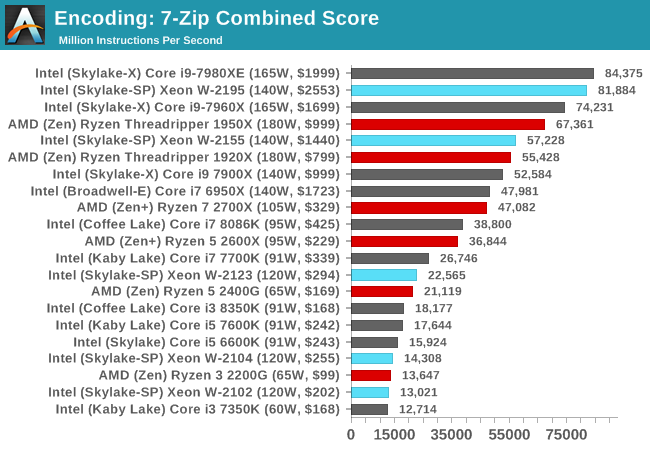

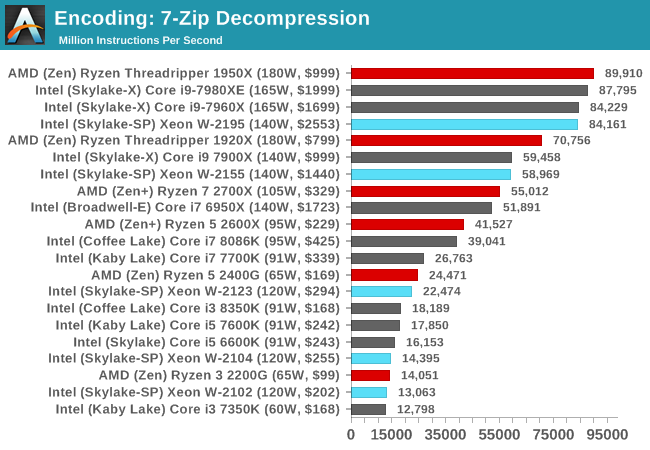
AMD's prowess in decompression means that it takes the top spot, however overall the W-2195 and the i9-7980XE are competing for top spot.
WinRAR 5.40
For the 2017 test suite, we move to the latest version of WinRAR in our compression test. WinRAR in some quarters is more user friendly that 7-Zip, hence its inclusion. Rather than use a benchmark mode as we did with 7-Zip, here we take a set of files representative of a generic stack (33 video files in 1.37 GB, 2834 smaller website files in 370 folders in 150 MB) of compressible and incompressible formats. The results shown are the time taken to encode the file. Due to DRAM caching, we run the test 10 times and take the average of the last five runs when the benchmark is in a steady state.
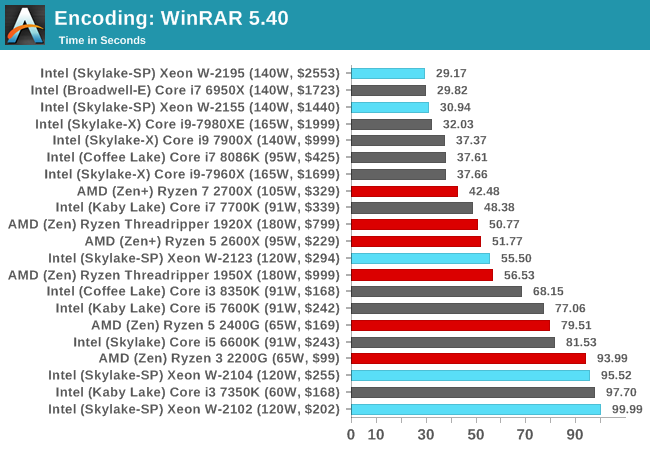
WinRAR likes cores and memory, and it seems that even the W-2155 can win against the Core i9-7980XE in this test. Despite the quad channel memory for the Xeon W quad core parts, the low frequency means they are bringing up the rear. The W-2123 hits mid-pack, actually beating the Threadripper 1950X in this test.
AES Encoding
Algorithms using AES coding have spread far and wide as a ubiquitous tool for encryption. Again, this is another CPU limited test, and modern CPUs have special AES pathways to accelerate their performance. We often see scaling in both frequency and cores with this benchmark. We use the latest version of TrueCrypt and run its benchmark mode over 1GB of in-DRAM data. Results shown are the GB/s average of encryption and decryption.

HandBrake v1.0.2 H264 and HEVC: link
As mentioned above, video transcoding (both encode and decode) is a hot topic in performance metrics as more and more content is being created. First consideration is the standard in which the video is encoded, which can be lossless or lossy, trade performance for file-size, trade quality for file-size, or all of the above can increase encoding rates to help accelerate decoding rates. Alongside Google's favorite codec, VP9, there are two others that are taking hold: H264, the older codec, is practically everywhere and is designed to be optimized for 1080p video, and HEVC (or H265) that is aimed to provide the same quality as H264 but at a lower file-size (or better quality for the same size). HEVC is important as 4K is streamed over the air, meaning less bits need to be transferred for the same quality content.
Handbrake is a favored tool for transcoding, and so our test regime takes care of three areas.
Low Quality/Resolution H264: Here we transcode a 640x266 H264 rip of a 2 hour film, and change the encoding from Main profile to High profile, using the very-fast preset.
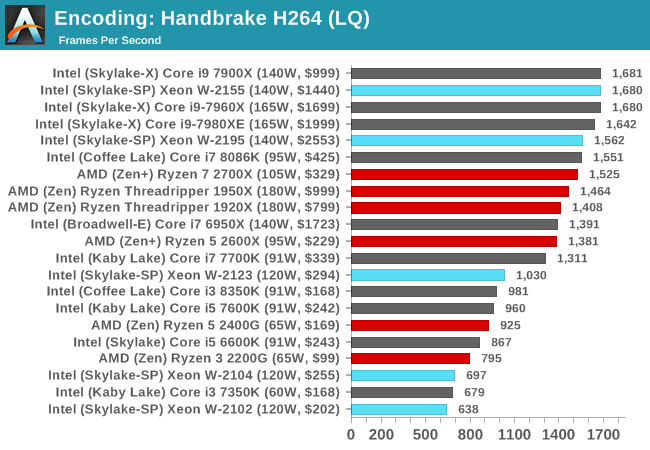
High Quality/Resolution H264: A similar test, but this time we take a ten-minute double 4K (3840x4320) file running at 60 Hz and transcode from Main to High, using the very-fast preset.
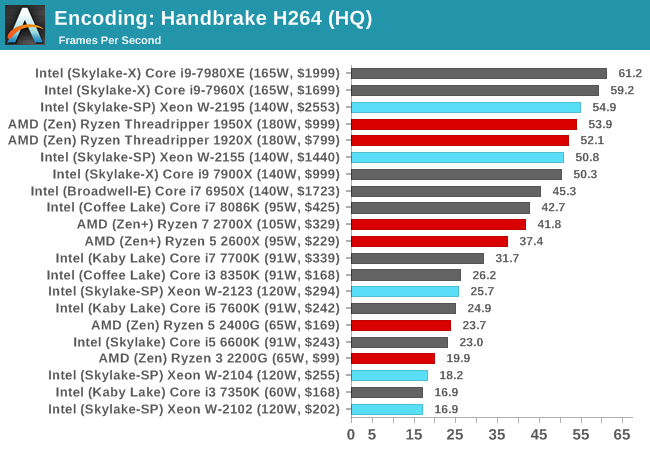
HEVC Test: Using the same video in HQ, we change the resolution and codec of the original video from 4K60 in H264 into 4K60 HEVC.
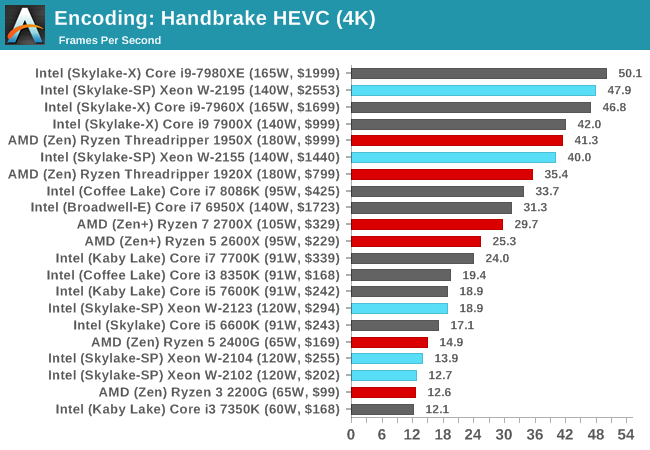










74 Comments
View All Comments
Alsw - Monday, July 30, 2018 - link
Nice article, unless i missed it it would be really handy to know all core Turbo boosts you acheived as i don't' think Intel release this info any more? i am in a situation where our FEA/CFD applications beneifit from both frequency and GHz so it is tricky, even before you start taking into acount whether dual CPU is better with the potential for performance variance data being passed between two physical CPU'sIan Cutress - Monday, July 30, 2018 - link
I thought I had the information, but I do not. I've reached out to Intel - normally the enterprise side of the business gives out this info, but the consumer side does not. I'll update the review when we get the details.eek2121 - Monday, July 30, 2018 - link
Looks like it's time to update your benchmark suite and redo benchmarks. Octane 2.0 has long since been retired, WebXPRT 15 as well. I like chrome, but you can disable updates in Firefox fairly easily. 7zip is at (!) 18.05. The version you are using is from 2010.Ian Cutress - Monday, July 30, 2018 - link
We've got a new benchmark suite for our next review, I put the finishing touches to it recently. The time we had these CPUs, it was not ready in time (also for retesting - a new suite takes about a month to bed in with older hardware).HStewart - Monday, July 30, 2018 - link
Ian, it would be really nice to see the performance benefits of AVX 512 in these benchmarks.I try to search for what applications are available that use AVX 512 - only thing I found was the following
https://www.hpcwire.com/2017/06/29/reinders-avx-51...
Ian Cutress - Monday, July 30, 2018 - link
I've got a few for our new suite. 3DPM has an AVX-512 mode now, and I've got the latest y-cruncherJoeyJoJo123 - Monday, July 30, 2018 - link
"AMD’s chiplet design will take a few generations to get used to"Is chiplet the silicon equivalent of calling someone a manlet? Lol.
jcc5169 - Monday, July 30, 2018 - link
There they go again! More Intel Fanboy propaganda !!!Ian Cutress - Monday, July 30, 2018 - link
So a review of a product = fan boy? What? Last week I was told I was an AMD shill.BurntMyBacon - Tuesday, July 31, 2018 - link
CONFIRMED! Ian is a double agent. Now that his cover is blown, he must commence emergency extraction procedures and call in a body double.Or maybe people just get a little too upset when things don't go as expected ..... Nah, I like the double agent story better. You'll have to let us know what your call signs were.